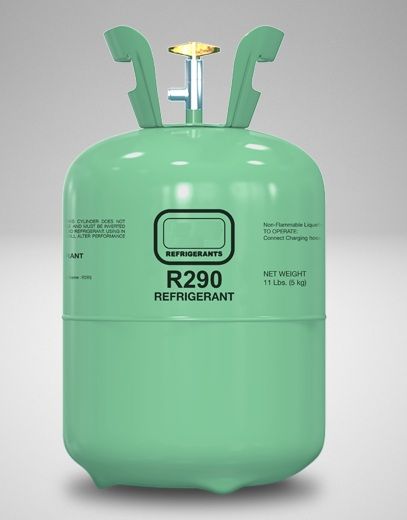R-290 on the rise in engineering system – General Overview
R290 is a very pure propane used in low-temperature refrigeration applications. R290 (propane) can also be used as an alternative refrigeran
Why R290
as a refrigerant
1. Natural Refrigerant
It is 100 percent natural and non-toxic to users and the environment.
2. Low GWP
GWP measures the potential of atmospheric warming produced by one kilogram of
every substance emitted to the atmosphere in comparison with the effect of one
kilogram of CO2 in a certain amount of time. This value measures the impact of
refrigerants on global warming, the higher the value the higher the impact.
3. Affordable
It is more affordable since it is more economical opposite to what
happens in synthetic refrigerants. Due to several taxes on HFC gases, the price
of refrigerants such as 410a increased significantly since 2014, while the
price of R290 remains unchanged and notably lower.
4. High efficiency
It has a 90% higher heat absorption capacity
than its predecessors. This means quicker recovery in temperature and lower
energy consumption.
Properties
of R-290
R290 has a high-temperature range
and with a critical point above 96°C can easily be used with seawater
condensers. The triple point lies at -188°C, making it suitable for both
chilled water and provision cooling purposes. The pressure range is comparable
to that of ammonia.
More
properties for R-290 can be found in the table below.
|
R-290 Properties |
|
|
Formula |
C3H8 |
|
Molecular weight (g/mol) |
44.1 |
|
Boiling temperature (°C) |
-42.1 |
|
Critical temperature (°C) |
96.7 |
|
Critical pressure
(Bar) |
42.5 |
|
Global Warming Potential |
3 |
|
Ozone Depletion Potential |
0 |
|
ASHRAE Safety Group |
A3 |
Benefits of
R290
Lower
Global Warming Potential (GWP) (~3) than R-22 (~1800), R-134a (~1450)
& R-404A (~3900)
Propane is characterized by a much lower GWP than R-404A, R-22,
and R-134A, which is the primary reason why the use of R-290 has increased in
recent years as a replacement for older, environmentally harmful materials. Its
capacity to absorb heat is about 90% higher than R134 or R404, which results in
faster temperature recovery and lower energy consumption. Additionally, its low
ozone-depleting properties and very low GWP make R290 one of the most
climate-friendly and cost-effective refrigerants on the market.
Cons of R290
The biggest disadvantage of propane and many
other hydrocarbons is flammability. The substance can ignite when placed under
the right conditions. That is why it is rated as an A3 refrigerant by ASHRAE. A
stands for non-toxic and 3 stands for 'high flammability'.
Compatibility with
materials
Almost all elastomers and plastomers found in refrigeration systems are
compatible with hydrocarbons. Incompatible materials to avoid are EPDM rubber,
natural rubber, and silicones. Refrigerant R290 is used in compressors with
polyester oil, which means that the material compatibility is almost the same
as R134a or R404A in terms of oil.
R290 Air-to-Water Heat Pump
Heat pump manufacturers are looking for alternative refrigerants due to the
fact that current refrigerants are not economically and environmentally
sustainable. Normal heat pumps are limited in performance at low ambient
temperatures, for example, the lower the ambient temperature, the weaker the
heating ability, in addition to that the reliability and low-temperature
environment will affect the stability and operational reliability of the
machine.
Future dependency of R290 Refrigerants
The number of R-290 applications is increasing exponentially
with each passing year. It doesn't matter where you are in the world. If you
are maintaining your standard home/commercial air conditioners and other
appliances, you will be working towards a propane system. It's only a matter of
time before we start seeing propane home air conditioners as mentioned above.
However, don't let the Inflammability scare you. Remember
that the charges on these systems are very small, and as long as you take the
proper precautions and follow standard safety practices, you should be fine.







.png)




No comments yet